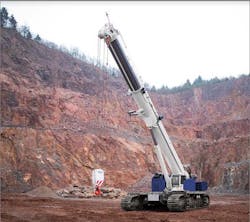Tadano GTC-2000 Telescopic-Boom Crawler Crane
According to Tadano, the new Tadano GTC-2000 telescopic-boom crawler crane has an actual
lifting capacity of more than 170 tons and a maximum load moment of 590 meter-tonnes, as well
as a track width that can be adjusted as necessary in both symmetrical and asymmetrical
configurations to accommodate job sites where space is at a premium. The new crane, says the
company, is able to move and telescope loads, and also luff down and retract the boom to travel
beneath overhead obstructions. In addition, says Tadano, the GTC-2000 is able to function as an
assist crane, for such applications as wind turbine pre-assembly.
Load charts for the crane’s 196.9-foot main boom are ample, says the company, even when the
crane is lifting on inclines of up to 4 degrees, requiring less on-site ground preparation,
compared with conventional lattice-boom crawler cranes. For example, says Tadano, the GTC-
2000 can lift 37.5 tons at a radius of 39.4 feet when working on an incline of 4 degrees with the
main boom at a length of 98.5 feet. Main-boom extensions are available in lengths of 16.4, 36.1,
55.8, and 75.5 feet and can be mechanically and hydraulically off set. Maximum tip heights of up
to 272.4 feet are possible. The 16.5-foot extension can be folded onto the side of the main boom
for transport.
In addition to a large lifting capacity, says Tadano, the GTC-2000 provides nearly the same
maneuverability and ease of operation as an excavator, using joystick controllers for the tracks.
The crane’s gradeability is 50 percent, maximum travel speed is 1.3 mph, and ground clearance
is 16.54 inches. According to Tadano, track widths have three standard positions—11.5, 15.6,
and 19.7 feet—which can also be used in an asymmetrical configuration. The tracks can be
adjusted both when stopped and when traveling, while the control system monitors the relevant
parameters to ensure the crane remains within an allowable configuration.
The machine is equipped with an intelligent control system based on the Demag IC-1 Plus
system, which automatically determines the permissible lifting capacity under consideration of a
number of factors, including ground incline, slewing angle, and track adjustment.
The transport width and height of the base crane are 9.85 feet each, says Tadano. The heaviest
transport unit weighs 51.2 tons. If necessary, weight can be reduced to 46.3 tons by removing
the extension beams used to adjust the track width. The two crawler units have a gross weight of
approximately 20.4 tons each when equipped with 3.3-foot track shoes; the two central ballast
units weigh 8.27 tons each; and the counterweights, including the base plate, weigh 49.6 tons.
The maximum operating weight of the crane is just under 165 tons.
Most assembly steps, says Tadano, can be controlled with the remote control or from the cab,
and most of the couplings are hydraulic quick-connect. In addition, says the company, the self-
assembly operation of the GTC-2000 includes the installation of two 8.27-ton central
counterweights that mount on the carrier, the crawler frames, and the 49.6-ton upper
counterweight that stacks on the superstructure and the second hoist.
The GTC-2000 crane uses an MTU 6-cylinder engine with an output of 308 hp and a torque of
958.83 ft-lbs. The engine complies with Euromot 5 specifications, as well as with Tier 4-Final
specifications. The engine has two operating modes: at a speed of 1,500 rpm, the engine operates
in an ECO mode for optimum fuel economy; at a speed of 1,800 rpm, a Power Boost function is
available, providing an output increase enabling simultaneous movements during crane
operation. Two hoists, primary and auxiliary hoists, are technically identical, says Tadano, with
both using 803.8 feet of 1-inch-thick wire rope with a line pull of 15.3 tons.
The GTC-2000 will be available in the second half of 2020.
